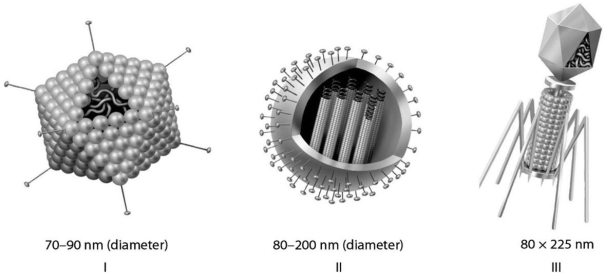A) I
B) II
C) III
D) IV
Correct Answer

verified
Correct Answer
verified
Multiple Choice
A bacterium is infected with an experimentally constructed bacteriophage composed of the T2 phage protein coat and T4 phage DNA.The new phages produced would have
A) T2 protein and T4 DNA.
B) T4 protein and T2 DNA.
C) T2 protein and T2 DNA.
D) T4 protein and T4 DNA.
Correct Answer

verified
Correct Answer
verified
Multiple Choice
Which of the following nucleic acids make(s) up viral genomes?
A) double-stranded RNA only
B) DNA only
C) single-stranded RNA only
D) DNA or RNA
Correct Answer

verified
Correct Answer
verified
Multiple Choice
In 1971,David Baltimore described a scheme for classifying viruses based on how the virus produces mRNA,referred to as the Baltimore requirements.The table below shows the results of testing five viruses (A-E) for nuclease sensitivity,the ability of the viral genome to act as an mRNA,and the presence (+) or absence (-) of each virus's own polymerase.  Based on the table above,which virus meets the requirements for a bacteriophage?
Based on the table above,which virus meets the requirements for a bacteriophage?
A) A
B) B
C) C
D) D
E) E
Correct Answer

verified
Correct Answer
verified
Multiple Choice
Which of the following statements correctly describes adenoviruses?
A) They contain RNA surrounded by a capsid.
B) They contain DNA surrounded by a capsid.
C) They contain RNA surrounded by a membranous envelope.
D) They are a type of bacteriophage.
Correct Answer

verified
Correct Answer
verified
Multiple Choice
 -Which of the three types of viruses shown in the figure above would you expect to include glycoproteins as part of their overall structure?
-Which of the three types of viruses shown in the figure above would you expect to include glycoproteins as part of their overall structure?
A) I only
B) II only
C) III only
D) I and II only
Correct Answer

verified
Correct Answer
verified
Multiple Choice
Which of the following responses correctly lists the order of events in a generalized viral replicative cycle?
A) Enzymes transcribe the viral genome into mRNA,the virus enters the cell,host enzymes replicate the viral genome.
B) The virus enters the cell,host enzymes replicate the viral genome,enzymes transcribe the viral genome into mRNA.
C) Host enzymes replicate the viral genome,enzymes transcribe the viral genome into mRNA,the virus enters the cell.
D) The virus enters the cell,enzymes transcribe the viral genome into mRNA,host enzymes replicate the viral genome.
Correct Answer

verified
Correct Answer
verified
Multiple Choice
How do antiviral drugs help to treat viral infections?
A) They remove all viruses from the infected host.
B) They interfere with viral replication.
C) They remove all viral proteins from the host.
D) They remove all viral mRNAs from the host.
Correct Answer

verified
Correct Answer
verified
Multiple Choice
You isolate an infectious substance that is capable of causing disease in plants,but you do not know whether the infectious agent is a bacterium,virus,or prion.You have four methods at your disposal that you can use to analyze the substance in order to determine the nature of the infectious agent. I.Treat the substance with nucleases that destroy all nucleic acids and then determine whether it is still infectious. II.Filter the substance to remove all elements smaller than what can be easily seen under a light microscope. III.Culture the substance by itself on nutritive medium,away from any plant cells. IV.Treat the sample with proteases that digest all proteins and then determine whether it is still infectious. If you already knew that the infectious agent was a prion,which treatment listed above would allow you to distinguish this?
A) I only
B) II only
C) III only
D) either I or IV
Correct Answer

verified
Correct Answer
verified
Multiple Choice
Which of the following characteristics,structures,or processes is common to both bacteria and viruses?
A) metabolism
B) ribosomes
C) genetic material composed of nucleic acid
D) cell division
Correct Answer

verified
Correct Answer
verified
Multiple Choice
Some people who have had a herpesvirus-mediated cold sore or genital sore may have flare-ups for the rest of their life.Why does this occur?
A) re-infection by a closely related herpesvirus of a different strain
B) re-infection by the same herpesvirus strain
C) co-infection with an unrelated virus that causes the same symptoms
D) copies of the herpesvirus genome remaining as mini-chromosomes in some host cell nuclei
Correct Answer

verified
Correct Answer
verified
Multiple Choice
Which of the following statements correctly describes the best predictor of how much damage a virus causes?
A) ability of the infected cell to undergo normal cell division
B) ability of the infected cell to carry on translation
C) whether the infected cell produces viral protein
D) whether the viral mRNA can be transcribed
Correct Answer

verified
Correct Answer
verified
Multiple Choice
Which of the following processes can be effective in preventing the onset of viral infection in humans?
A) taking vitamins
B) getting vaccinated
C) taking antibiotics
D) applying antiseptics
Correct Answer

verified
Correct Answer
verified
Multiple Choice
Which of the following statements accurately describes plant virus infections?
A) They can be controlled by the use of antibiotics.
B) They are spread via the plasmodesmata.
C) They have little effect on plant growth.
D) They are rarely spread by insects.
Correct Answer

verified
Correct Answer
verified
Multiple Choice
Which of the following characteristics determine a virus's host range?
A) the enzymes carried by the virus
B) whether its nucleic acid is DNA or RNA
C) the proteins in the host's cytoplasm
D) the proteins on its surface and that of the host
Correct Answer

verified
Correct Answer
verified
Showing 21 - 35 of 35
Related Exams